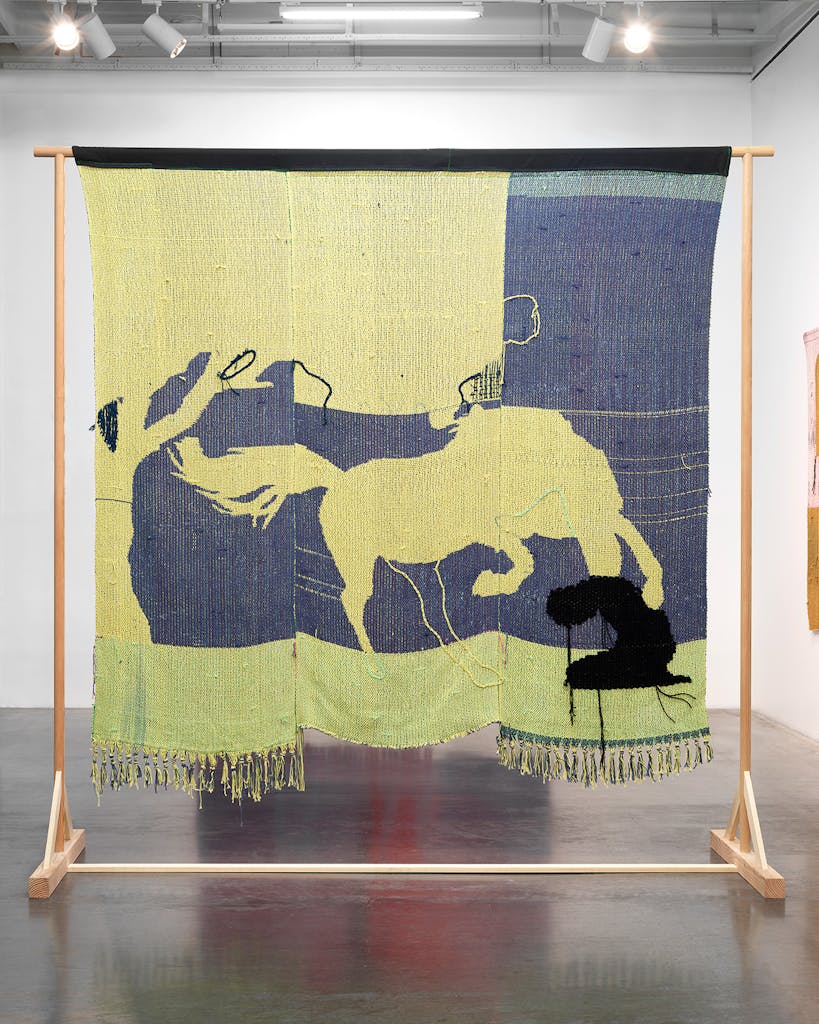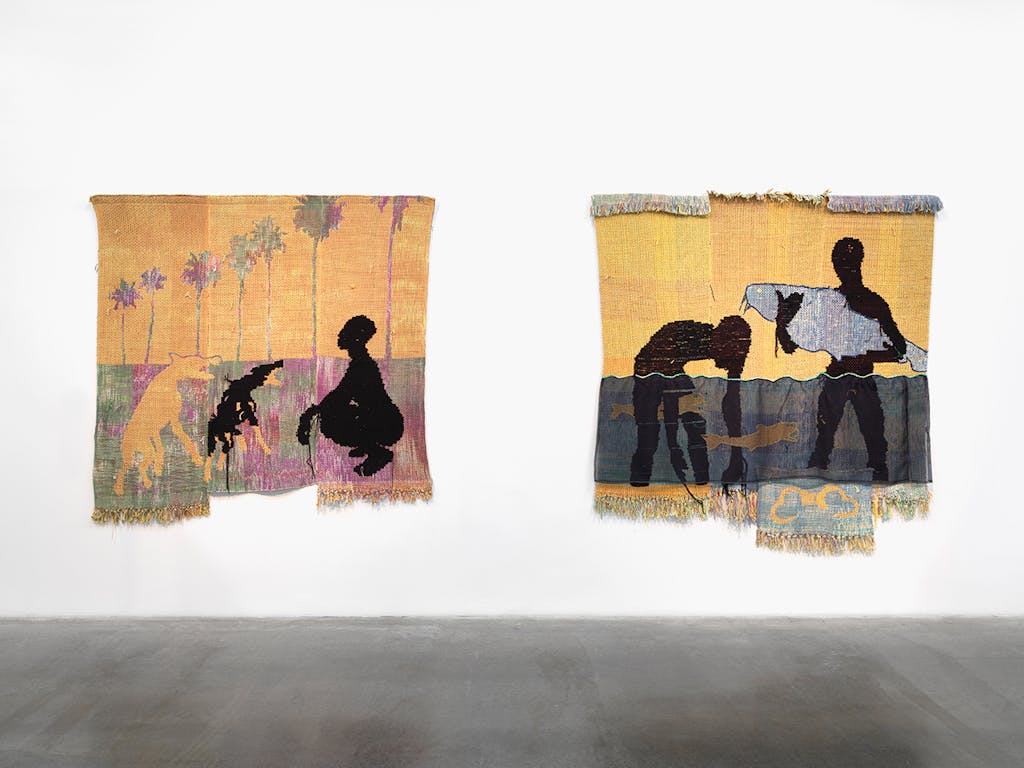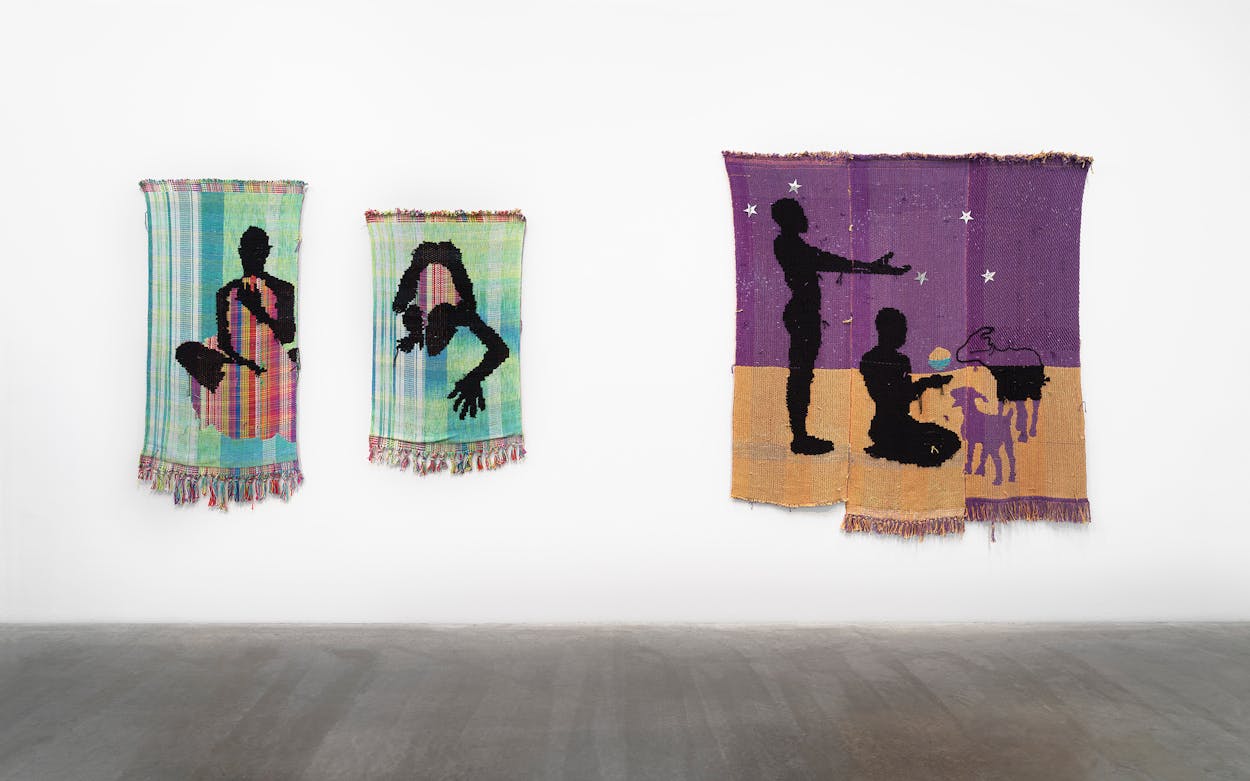The visual artist Diedrick Brackens was born in Mexia in 1989. The small city, which has a population of about 7,500, is home to many members of Brackens’s extended family; although his immediate family moved around for his father’s job in the military, his parents wanted to maintain a connection to their family and Texas. No matter where Brackens and his family lived, he spent every summer of his childhood, and many in his adulthood, returning to Mexia—a place that now frequently informs his woven tapestries.
For Brackens, weaving is a form of language that evolves during every step of the process. And in his new exhibition at the Blanton Museum of Art, “Diedrick Brackens: darling divined,“ opening on October 17, he pays tribute both to his upbringing and his family—not just in the stories of Blackness and queerness he chooses to tell, but also in the materials these pieces are made from. Much of his work in the show is made from a mix of acrylic and cotton; Brackens uses cotton because it’s a versatile material, but also to honor his grandmother, who picked cotton as a child in Texas. “She had to do this thing that comes along with this awful history,” he told the New York Times. “And if that is part of my story, I have to make very beautiful things.”
There is something beautiful, and indeed divine, about Brackens’s textiles. The figures in Brackens’s pieces, who are often Black, depict scenes of intimacy and ritual, often in reimaginings of biblical stories and the more immediate history of his family, including a Juneteenth tragedy that reshaped Mexia just a few years before he was born. Texas Monthly spoke with Brackens about the stories he keeps returning to in his weavings, how he’s adjusted to the pandemic, and what it means to bring his art back home to Texas.
Texas Monthly: Do you think being raised in the more rural and suburban parts of Texas has shaped your art in any way?
Diedrick Brackens: I think so … a lot of the aesthetics that I respond to and images that move me in the world stem from being in that landscape, looking at the way that my mother and grandmother move or put things together and lay stuff out. I think also growing up in the church, there are stories and parables and other things that resonate with those stories, or butt up against them, in ways that make them feel new to me. I think those things have informed my way of seeing.
TM: Are there any parables or stories that you find yourself coming back to again and again?
DB: Yeah, I would say one story that comes back to me often is the prodigal son. It’s something I’ve been thinking about, just as it relates to this show being in Texas. I feel often when I come back or engage with people from Texas there’s always this outsized pride. Like, “You’re having a show in Texas and you’re from here.” People who don’t even know you, right? There’s just [this sense of], “Oh, my God, you did something and you’re from here.” The character, they go away, but [he] can always find himself circling that original center again.
One of the works in the show is called “opening tombs beneath the heart,” and it’s these two figures, one reaching out to the other. And at their feet is this slain or dead pig. And for me, it thinks about, similarly to that story, that this son returns home and the father kills the prize, that fatted calf, to have this celebration. I’m always thinking about how people might carve out intimacy between themselves [and] that return or a parallel to that story that I’m interested in, how people find each other and make space for each other to be tender.
TM: How do you see yourself in that story?
DB: I originally left Texas as an adult in 2012. And when I left, I was going away to grad school. I was very much like, “Oh my God, I’m finally out.” [Laughs] But as soon as I left, I was like, “Oh, my God, I have lost something that was so informative of me being me.” It was heightened when I made it to San Francisco, of all places. It operates on the opposite set of stereotypes as Texas as being a super liberal, experimental, way-out-there place. But I felt so often that it was locked into a certain understanding of Texas. I would go somewhere and give my ID to go into a club or buy liquor and someone would be like, “Oh my God, you’re from Texas.” And I would go, “Wow, this is really strange to hear and try to navigate,” because it felt bigoted in a way. I was like, “I’m proud to be from Texas.” If someone like me, this young Black queer person survived in Texas, clearly there’s a lot of space for different identities there. As I was running away from it, I was then put on the guard to defend it and to realize, “Oh, no, actually, it shaped you quite well.”

TM: There’s so much happening right now, especially with the pandemic. How is that showing up in your work?
DB: In the beginning, it was debilitating for me specifically. People were like, “We’re going to have all of this time in the house,” like, I’m gonna be so productive. I’m going to make six times the work I normally make. But then the reality for me set in. I am alone. I don’t have this sort of community around me that I depend on, and now I realize it’s so much harder to get the things that I need to make work. And I think in my practice, in general, I don’t want to rely on making work about things that will produce images that are negative. “Negative” is not the word I need, but I don’t want bad things to have to happen to make good work.
Right as the social distancing/stay at home orders went into effect in L.A., I’d just finished working on a show that was going to debut in New York [about the AIDS crisis]. For me it was really [destabilizing]. I’ve been making work about one plague as we enter another pandemic. I just needed time to process these things. I’m never interested in being on the pulse. I don’t think I’ve ever wanted to respond to the moment at the moment. But because I’m interested in history, I think these things tend to resonate no matter what you’re talking about or when they appear, in certain ways. These are just things that are undercurrents that we’re always going to be feeling at some point. I’ve just learned to trust that at some point it will be relevant.
TM: Your upcoming exhibition at the Blanton first premiered at the New Museum in New York in 2019. What do you think people may get from it now, years after you first created it?
DB: A lot of my interest in creating this show was about longing to be with one another. Typically, a lot of the works are about these kinds of pairs. One figure with another. There’s a lot of hints of romantic love, but also just tenderness between two figures and/or this kind of suspension of violence between figures. But there’s a lot of ideas around it, of achieving feeling. And that these things are predestined. In this idea of people searching for “true love,” there’s this idea that you believe that this thing already exists out there and it’s just your job to find it. The way that I was thinking about divine, as in divination. And I think right now a lot of folks who’ve been isolated or alone [will] come into a room with textiles that are so much about touch, whether or not you can actually do that. It will hopefully resonate in this interior space, that you will feel the tactile nature of the work in the way that resonates with being close to another person.
TM: I wonder about the connection between two pieces in the exhibition. One is the cup is a cloud and the other is bitter attendance, drowned jubilee.

DB: I think they were made the same year. Bitter attendance, drowned jubilee was made first and then later in the fall, I made [a cup is a cloud]. In making bitter attendance, I was relying on this historical event that happened in my hometown to create the imagery. What I found after I’d made these weavings was that they had this Christian iconography that I was not aware of when I made them. But after seeing them and having conversations with people, there were these questions about these fish and Jesus. I realized that unconsciously a lot of these things were cropping up in the work. I started to intentionally try to create these situations that relied on symbolism from the Bible.
In this case, it was using goats, snakes, and fish because they had been throughout the Bible identified with being unclean or with the devil. For me, I was like, “I wonder if I can take these signs that we recognize from a Christian sense as being in league with the devil or things that you’re not supposed to consume.” If I could flip it, if I could somehow insert these ideas around transformation or pulled or teased them away from these ideas being evil. And I don’t know that I was successful or not. But for me, it was like, I want to invoke these ideas of caretaking, I want to think about the ideas of ritual.
TM: You mentioned that bitter attendance, drowned jubilee is based on an event that happened in your hometown. Can you tell me more about that?
DB: In 1981, at a Juneteenth celebration in Mexia, three young men in their late teens were arrested for possession of marijuana. About twenty to thirty thousand people at the time would come to this event. It was centered around the lake and it would block off the road access, so it would be hard to get in and out. The police put the three boys in a boat to transport them across the lake to the local sheriff’s office. The boat gets halfway across the lake. It capsizes. The four policemen are either saved or swim to safety, and the three handcuffed boys drown. And after this, basically the townspeople and all of the people that came to the Juneteenth celebration say, “They were drowned because they were handcuffed. They weren’t given life jackets.” And the police officers maintained that they weren’t handcuffed, and they just drowned. It’s a small town, so all of these people were like, “We knew them our whole lives, they could swim.” This event really changed race relations of the town.
My whole life I heard the story from my mother, my grandmother, my cousins, people who were there and not there and why they were there or not there. As a child, it was just a story of these boys who drowned in the lake. As I got older, and particularly around the time that I made these weavings, I was like, “Wait a minute, what is that story? There was a Juneteenth celebration that used to happen here, and it was the biggest in the state. That’s crazy.” Realizing all of this stuff happened on a celebration of Black liberation in the place that I’m from. And this so closely mirrors so many of the things that are happening around Black people by the police in this contemporary moment. And it just made me think about what kind of trajectory was this particular place on before this happened. And now if two hundred people show up for this thing, that’s a success. For the bottom to fall out of this thing … I just couldn’t quite make sense of it. And not to say that I can now. But for me, weaving was a way to think through that event.
The three catfish were a stand-in for these three boys, trying to capture these lives lost. Thinking about these catfishes being the spirits of these boys, and having the handcuffs floating at the bottom of the lake bed, was my way to take this real story and mythologize it in a way, and think about a different outcome without being too specific or too didactic. I can’t change it, but I want to insert these other possibilities into the folklore.
This interview has been edited for clarity and length.
- More About:
- Art








